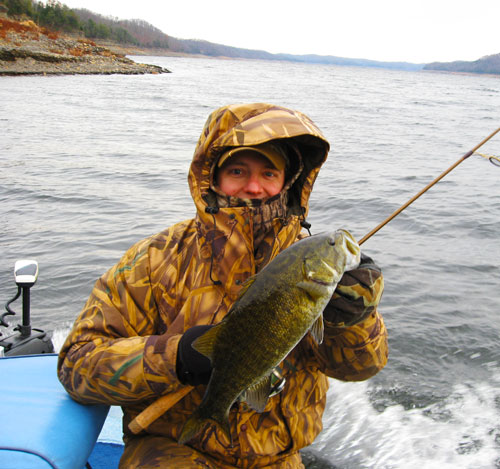BY Lee McClellan
The swim jig and the swimming retrieve are now mainstays for trophy largemouth from heavy cover or weeds. They also shine for catching suspended largemouth bass in clear lakes.
Anglers fishing the world class smallmouth reservoirs in Kentucky and Tennessee fished a swim jig for decades, but they called it the fly and rind.
A fly in Montana means a lure for trout; a fly in Kentucky and Tennessee means a hair jig, made from tying bucktail, rabbit fur or synthetic craft fur onto the shank of a lead-head jig. The rind is a pork chunk trailer, a nearly forgotten staple of jig fishing for bass.

“With a hair jig, you get a small profile, which smallmouths in reservoirs like Dale Hollow prefer, especially in late fall, winter and early spring,” said Chad Miles, administrative director of the Kentucky Fish and Wildlife Foundation.
Miles is a smallmouth wizard who routinely catches fish over 5 pounds in fall, winter and spring from Dale Hollow, Laurel River Lake and Lake Cumberland. He loves the subtle, flowing nature of the hair jig that perfectly imitates baitfish or crawfish movements in cold water.
The pork trailer also moves subtly and the combination comes through the water like a stick, a trait that goads large smallmouth bass into striking.
A small tackle box, satchel or lure wrap loaded with several 1/8 – or 1/4-ounce black, olive and brown hair jigs and a jar each of black or brown pork trailers are all you need for fishing the fly and rind. Its beauty is simplicity. This setup also catches spotted and largemouth bass as well as trophy smallmouth in the colder months.
Fish the fly and rind on a 6- to 7-foot medium-light or medium power spinning rod and accompanying reel, spooled with 6- to 8-pound test pure fluorocarbon or fluorocarbon-coated line.
The stealth of fluorocarbon line really helps in fall, winter and early spring, plus its density better transmits strikes. The venerable Uncle Josh Company still produces pork jig trailers.
The best sizes for the fly and rind are the No. 101 Spinning Frog and the No. 18 Mini Frog, but many old timers used the original size No. 11 Pork Frog and trimmed it down. You can cut the No. 11 Pork Frog in half and trim it to look like an elongated tear drop for an even more subtle presentation. If you only had one color for a trailer, choose black.
Fishing the fly and rind properly requires a swimming retrieve, targeting grumpy bass suspended above bottom. You simply cast it out, let it sink to the bottom and then swim it back just above the bottom. Swimming the fly and rind really excels on the clear waters of the smallmouth reservoirs of southeastern Kentucky such as Laurel River Lake and Lake Cumberland.
A 1/8-ounce fly looks the most natural with its slow fall rate, but can be difficult for most anglers to work correctly from a boat. A 1/4-ounce fly is easier.
The small coves and cuts along the main lake or in major creek arms that slope in a “V” shape make the highest percentage places to swim a fly and rind. Smallmouth often suspend just above the bottom in these spots, so throw your fly right in the middle of the cut, let it sink and swim it back to the boat.
The best small coves or cuts lie near the submerged river or major creek channel with a bottom comprised of shale, gravel or fist-sized rocks. These areas draw crawfish burrowing in for the winter as well as baitfish. The ones that look the least “fishy” often hold bigger smallmouths.
These spots also offer excellent opportunity for bank fishing by using boat ramps, state parks or other public access spots to walk to these areas and fish. You can easily carry the hair jigs, jars of pork trailers and a multi-tool. A 1/8-ounce jig works best for bank fishing.
Anglers should also swim their jig along the side of points in these areas and over the point well off the bank. Your drag should slip on the hookset as any fish that strikes in these spots will likely be large.
The fly and rind also excels at picking off spotted and largemouth bass suspended beside bluffs. Craggy bluffs riven with fissures and shelves and formed by the original creek or river make excellent cold weather spots for these fish.
Swimming a fly and rind along a channel ledge in mid-depth reservoirs such as Barren River, Green River, Nolin River and Rough River also fools lethargic largemouth, their vigor drained by the cold water of late fall and winter. A black fly with matching trailer makes the best color choice for bluffs and channel ledges.
Pork trailers are more difficult to deal with than plastic trailers. Some anglers strike their pork rinds with a meat tenderizing hammer to soften them. They need to stay wet. Don’t leave them on the jig after fishing or you will have a chore removing them after they dry and harden.
To remove a pork trailer from the jig, flip the jig upside down and rotate the trailer so the trailing edge faces the hook shank and jig head and gently pull down. They usually pop off, but may need an additional cut with a sharp knife.
Swim and fly and rind this fall and winter and fool a trophy smallmouth, largemouth or spotted bass. This combo still fools them after all these years.
Author Lee McClellan is a nationally award-winning associate editor for Kentucky Afield magazine, the official publication of the Kentucky Department of Fish and Wildlife Resources. He is a life-long hunter and angler, with a passion for smallmouth bass fishing.


Be the first to comment